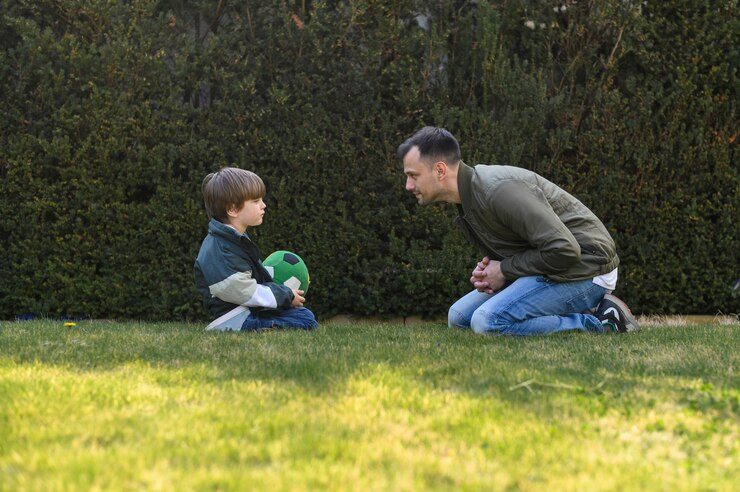Helping Kids Manage Big Emotions (Without Losing Your Cool)
Ceara Deno, MD • December 2, 2024
Schedule A Free Call
Helping Kids with Big Emotions (Without Losing Your Cool)

Parenting kids with big feelings can sometimes feel like you’re walking through a minefield of meltdowns.
But those explosive moments? They’re actually golden opportunities to teach your child emotional intelligence and even build a stronger connection.
How?
1. Give Their Feelings a Name:
When emotions are high, kids often can’t find the words to explain what’s happening inside. That’s where you step in as their “emotion translator.” Try saying:
“It seems like you’re feeling frustrated.”
“I wonder if you’re feeling sad about that.”
These phrases help them connect the dots between what they’re feeling and why.
And if you get it wrong? No worries—kids love correcting us!
2. Validate, Don’t Fix:
Once their feelings are named, show them that you understand.
Skip the “calm down” or “it’s not a big deal,” and instead say:
“That makes sense—you were so excited, and now it didn’t happen.”
“I’d feel frustrated too if someone took my turn.”
Acknowledging their feelings doesn’t mean you’re giving in; it’s helping them feel seen and heard.
3. Make It Silly:
Emotions don’t have to be so serious!
Lower the stakes by playing a game, telling a silly story, or making up ridiculous scenarios about their feelings.
(“If Mad were a color, would it be fire-breathing dragon red or exploding volcano orange?”)
Sometimes laughter is the perfect release valve.
4. Share Your Own Feelings:
Kids learn best by example.
Share moments when you felt mad, sad, or frustrated—and how you managed it.
(“Remember when I spilled my coffee? I was SO upset! I took a deep breath and cleaned it up anyway.”)
Big feelings might feel messy and overwhelming, but they’re a normal part of growing up—and parenting.
With a little empathy, validation, and humor, you can help your child not just process their emotions but learn to thrive with them.
And who knows? You might just learn a thing or two about handling your own big feelings along the way.

For highly sensitive children especially, punishments often backfire, making behavior and your relationship worse than ever. How can we discipline highly sensitive children in effective ways that are based on trust, learning, and maintaining a close, connected relationship with their parents? We want to avoid punishments, and instead set boundaries with empathy and kindness, practice collaborative problem-solving, and do emotion coaching.

Do you have an argumentative or defiant kid? Many of the families I coach do.
If you have an argumentative child who needs to be in control, who is resistant and defiant with even small requests, who refuses to go outside his comfort zone, or who struggles with disappointment or embarrassment, this explains why your child is so challenging, and how to help them be more flexible and cooperative.

Overstimulation happens when the amount of sensory input is too much, leading to feelings of exhaustion, overwhelm, or emotional shut down. These symptoms are more likely in highly sensitive children and parents, who are more affected by sensory inputs. How can we help avoid and manage feelings of overstimulation? How can we help our children who struggle with overstimulation?

Feel like you’re running on empty as a parent? Like nothing you try with your child ever works? Like you’re chronically frustrated and exhausted? Like you can’t feel joy as a parent?
It’s very possible you are suffering from parenting burnout. And you’re not alone.
Many parents of sensitive children struggle with parenting burnout. Here’s what burnout is and how to heal it.

Does your child feels everythin g more intensely than other kids? If this sounds like your child, you’re not alone. Kids who are highly sensitive experience everything more deeply. This trait, sensory processing sensitivity, is present in 15-20% of children. If this sounds like your child, they likely have bigger feelings than other children, which can cause power struggles and meltdowns. How do you know if your child is highly sensitive? Here is a checklist with 10 common signs a child might be highly sensitive. 1.) Strong Reactions to Sensory Stimuli Does your child struggle with loud noises, bright lights, or scratchy fabrics more than other kids? 2.) Deep Emotional Responses Does your child cry more easily or feel big emotions like sadness, anger, or joy more intensely than other kids? 3.) Overwhelm in Crowds or Busy Places Does your child gets anxious or overstimulated in crowded areas like malls or parties? 4.) Takes Criticism Deeply Does your child get deeply affected by a simple correction or criticism? 5.) Empathy for Others Does your child often pick up on other people's emotions and feel them deeply? 6.) Struggles with Change Does your child struggle with new situations or transitions, like starting a new school? 7.) Needs Alone Time to Recharge Does your child need quiet time alone to decompress and feel calm after a busy day? 8.) Notice Small Details Does your child often pick up little things others might miss, like a slight change in your mood or a small decoration in a room? 9.) Perfectionism Does your child have high standards for themselves and others, and get frustrated if things don’t go perfectly? 10.) Intense Focus Does your child have a tendency to get fully absorbed and focus deeply on a task or subject? Do any of these sound like your child? Do all of them sound like your child? High sensitivity is a strength. But it can also cause challenges, especially when children need more support, or they don’t yet have the skills they need to navigate challenges. If your child is struggling right now, I’d love to help your family create more peace and harmony. You can schedule a call with me using the scheduling link above, and I can help with specific advice for your child and your family.

Some kids are quieter, and share less with their parents. These kids can be a challenge, since they don’t share their feelings easily. Parents can wonder what’s going on for their child, and it can be very challenging when a child is upset, but won’t share what’s going on for them.
Both ways of communication, kids who talk more and tend to “think out loud,” as well as quieter kids who tend to think before speaking--are normal and healthy.

Do you struggle to get your highly sensitive child to go places? The store, a walk outside, a party, or even school, and your child just does not want to go? You are not alone. Here I explain why this happens, and how parents can best respond. I explain the best way to help kids go places, even when they don’t want to.

As parents, it can be very unsettling when children lie to us. While lying is a very normal part of childhood development, there are reasons that highly sensitive children may be more prone to lying. And so we want to look underneath the behavior to better understand why they are struggling to tell the truth. Also, how we respond will make a difference as to whether our child is able to tell the truth in the future.

Have you ever thought, “If only my partner would parent differently, life would be so much easier?” You’re not alone. Parenting differences are incredibly common--and incredibly frustrating. Especially when raising a highly sensitive child. The good news? You don’t have to agree on everything to be an amazing team. Instead of trying to change your partner, try these three strategies to create more harmony: 1️⃣ Get Curious, Not Combative Instead of reacting with frustration, try asking, “Help me understand what's most important to you in this situation?” Your partner has a good reason for what they do as a parent. When we assume good intentions, and seek to understand, we are more likely to get good will and openness in return. Most parenting comes from a place of deep love. When we understand our partner’s heart and thinking, we are more likely to find areas of common ground. 2️⃣ Appreciate the Balance Parenting differences can actually benefit children! Parenting differences can be complementary. Different perspectives makes the family system stronger. Think of the differences like having different types of tools in a toolbox, rather than having a hammer only. With diverse tools, you can fix more things than if you only had a hammer. 3️⃣ Lead by Example The best way to influence your partner’s parenting? Show, don’t tell. When one parent can stay calm during a meltdown, or hold a peaceful boundary—the other partner is way more likely to adopt what works. When children respond positively, your partner will be noticing. Leading by example is incredibly powerful. ****************** Would you love to be on the same parenting page with your partner or coparent? Would you love a more peaceful, connected home? Let’s talk. Together, I’d love to help you and/or your partner break patterns that aren’t serving you and your family. Maybe you’d like to be better at staying calm and not losing your temper. Maybe your partner wants to do this. Maybe you’re fighting with your kids over every little thing. Maybe your preschooler only wants one parent, and you’re not sure how to change this pattern. Whatever the challenge is, I’d love to help create a more peaceful home for you and your family.

Parents, I see you--beating yourself up. Criticizing your parenting. Feeling like a failure. I get it. I know you have impossibly high standards for yourself. Y ou want to be PERFECT. You want to get it right, the first time, every time, as a parent. I get it. You care so much, and your heart is so big and strong. Then, when you aren’t perfect, which, newsflash, WILL HAPPEN, you make it mean that you’re failing. That you’re not good enough. But this story is NOT THE TRUTH ABOUT YOU AS A PARENT. Yes, you are imperfect. (Like every person to ever exist.) And, yes, you will make mistakes. (Like every person to ever exist.) But you are lovable and perfect in your imperfection, like your child. You are learning and making mistakes, like your child. You deserve compassion and love, like your child. You can learn and grow and change, like your child. ************ If you’re ready to ditch the guilt and shame as a parent, and grow in self-compassion and love, we should chat. I know how easy it is to judge yourself and create a shame story about yourself. But the pressure this creates doesn’t serve you, your child, or your relationship. If you’re ready to ditch the guilt and create more self-compassion, love and connection, I’d love to help. If you’re ready to hold yourself with more gentleness and understanding, let’s schedule a free call together, and create a plan for you to have more peace and connection in your home.

